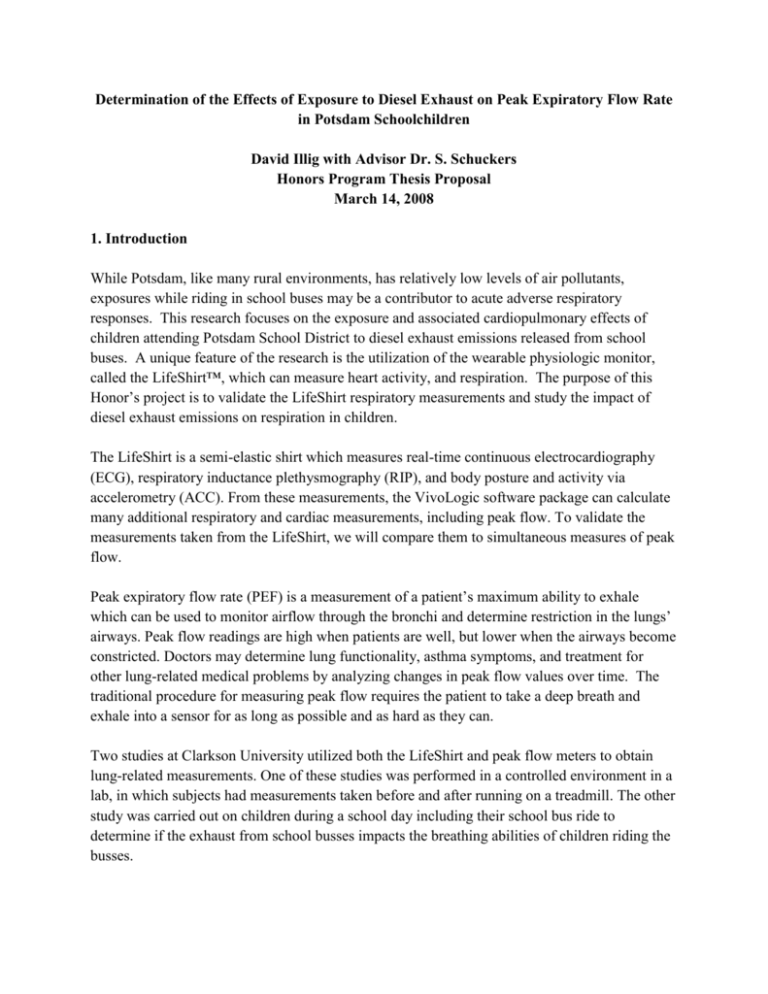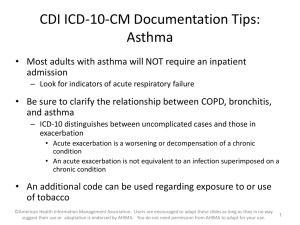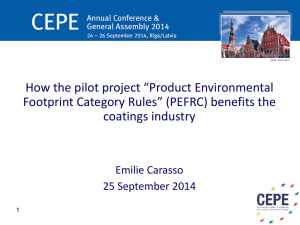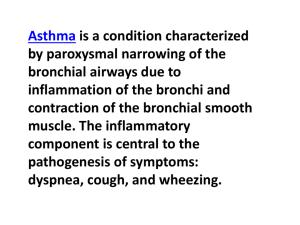Determination of the Effects of Exposure to Diesel Exhaust on Peak
advertisement

Determination of the Effects of Exposure to Diesel Exhaust on Peak Expiratory Flow Rate in Potsdam Schoolchildren David Illig with Advisor Dr. S. Schuckers Honors Program Thesis Proposal March 14, 2008 1. Introduction While Potsdam, like many rural environments, has relatively low levels of air pollutants, exposures while riding in school buses may be a contributor to acute adverse respiratory responses. This research focuses on the exposure and associated cardiopulmonary effects of children attending Potsdam School District to diesel exhaust emissions released from school buses. A unique feature of the research is the utilization of the wearable physiologic monitor, called the LifeShirt™, which can measure heart activity, and respiration. The purpose of this Honor’s project is to validate the LifeShirt respiratory measurements and study the impact of diesel exhaust emissions on respiration in children. The LifeShirt is a semi-elastic shirt which measures real-time continuous electrocardiography (ECG), respiratory inductance plethysmography (RIP), and body posture and activity via accelerometry (ACC). From these measurements, the VivoLogic software package can calculate many additional respiratory and cardiac measurements, including peak flow. To validate the measurements taken from the LifeShirt, we will compare them to simultaneous measures of peak flow. Peak expiratory flow rate (PEF) is a measurement of a patient’s maximum ability to exhale which can be used to monitor airflow through the bronchi and determine restriction in the lungs’ airways. Peak flow readings are high when patients are well, but lower when the airways become constricted. Doctors may determine lung functionality, asthma symptoms, and treatment for other lung-related medical problems by analyzing changes in peak flow values over time. The traditional procedure for measuring peak flow requires the patient to take a deep breath and exhale into a sensor for as long as possible and as hard as they can. Two studies at Clarkson University utilized both the LifeShirt and peak flow meters to obtain lung-related measurements. One of these studies was performed in a controlled environment in a lab, in which subjects had measurements taken before and after running on a treadmill. The other study was carried out on children during a school day including their school bus ride to determine if the exhaust from school busses impacts the breathing abilities of children riding the busses. A comparison of measurements from peak flow meters and the LifeShirt will be performed to determine the accuracy of the LifeShirt’s measurements. If the LifeShirt’s measurements are comparable to the peak flow meter’s measurements, MATLAB software and signal processing techniques will be used to determine an automated means of extracting peak flow measurements from the raw data recorded by the LifeShirt. These peak flow measurements will then be used to aid in studying the impact of diesel exhaust emissions on respiration in children recorded in the study mentioned previously. 2. Background 2.1 Respiratory Inductance Plethysmography Plethysmography is a noninvasive lung volume measurement technique based on Boyle’s Law, which states that the product of pressure and volume is a constant.1,2 In plethysmography, changes in thoracic pressure and volume changes during respiratory efforts are used to calculate lung volume.1,2 RIP measures changes in inductance of the body and produces a volume signal from these measures.3 Utilizing a traditional plethysmograph, a patient is placed inside of a sealed chamber containing a mouthpiece into which the patient is required to breath.1 This method thus requires the patient to go to a hospital or other medical facility, as the equipment required is not portable. With RIP however, small, easily portable devices such as the LifeShirt can be used to measure lung volume. It has also been shown that the results of using a device such as the LifeShirt to measure respiratory data outside of a laboratory environment possess high agreement with measurement results from laboratory equipment.3,4 The LifeShirt system incorporates rib cage and abdominal inductive plethysmographic sensors whose sum is equal to total tidal volume.5 From the LifeShirt measurement of tidal volume, many additional respiratory parameters can be derived.5 2.2 Peak Expiratory Flow Rate PEF is defined as the rate at which tidal volume changes with respect to time. PEF measures a patient’s maximum ability to exhale.6 PEF readings are used to indicate how narrow or open the airways are.6 Thus, when PEF is high, a patient is well, and a lower PEF indicates that the patient’s airways are constricted. From changes in recorded PEF values, over time patients and doctors may determine lung functionality, the presence and severity of asthma symptoms, and potential treatment options for respiratory problems. PEF is usually measured by requiring a patient to take a deep breath and exhale into a sensor for as long and as hard as possible. However, this requires that patients be able to comprehend instructions given to them by a doctor, making this test unsuitable for young, unconscious, or sedated patients. This procedure also would not be appropriate for patients who have medical limitations preventing them from making vigorous respiratory efforts. 2.3 Lung Volume Measurements in Children Assessment of respiratory function is important during early childhood as the lungs and airways grow.7 Lung volume measurements have been used to assess the long-term effects of lung trauma on young children, including bronchopulmonary dysplasia and bronchiolitis.1 Symptoms of cystic fibrosis, pulmonary hypoplasia, pulmonary fibrosis, and musculoskeletal abnormalities can also be detected using lung volume measurements.1 Tidal volume and its derived parameters can also be used to detect the presence of asthma symptoms in children.1,3 Although there are many different means of measuring lung volume, including gas dilution techniques, plethysmography, radiological methods, and magnetic resonance imaging, most of these require that the patient be tested with a large, nonportable piece of equipment.1,8 For very young children or children who are uncooperative with doctor’s instructions, it may not be possible to use these procedures to measure lung volume.8 RIP, however, has been shown to be relatively simple to perform, require minimal patient cooperation, and apply to a broad range of age groups.7 This makes a device such as the LifeShirt ideal for measuring lung volume parameters in young children. 3. Research Methodology In completing this research project, three major objectives will need to be accomplished. First, a means of comparing the PEF measurement of the LifeShirt to the values recorded by the peak flow meter must be created. The algorithm used to compare these results will then be translated into a MATLAB program to be used to efficiently and consistently extract PEF values from the LifeShirt data. Finally, once the MATLAB program has been used on all subjects, statistical tests will be used to determine if the children’s respiration was affected by the diesel exhaust of the school busses. 3.1 Comparison between Peak Expiratory Flow Rate Measurement When the study on the impact of diesel exhaust emissions on respiration in children was performed, peak flow meters were used to measure PEF independent of the LifeShirt. At that time, it was not known if the VivoLogic software utilized to analyze LifeShirt data could be used to directly calculate PEF. Difficulty in interpreting the PEF measurements recorded by experimentalists and in synchronizing the LifeShirt’s internal clock recording with external clocks provided motivation for a way to directly acquire PEF measurements from the LifeShirt data. With that in mind, an early objective of this project was to determine a means of calculating PEF directly from tidal volume. It was soon determined that the software can in fact measure PEF; however, the VivoLogic manual warns that the measure of PEF by the LifeShirt may be significantly higher than that measured from peak flow meters.5 Currently efforts are being made to calculate PEF using the tidal volume and time measurements made by the LifeShirt in a way such that this recording correlates with the measurements made using the peak flow meters, with particular focus on creating an appropriate algorithm for determining when a breath has been completed. 3.2 Creation of MATLAB Program to Extract Peak Expiratory Flow Rate from Data Once an algorithm for determining PEF from the LifeShirt measurements has been created that correlates with the peak flow meter measurements, this algorithm will be translated into a computer program. The MATLAB programming language was selected as it is already in use by Dr. Schuckers and others analyzing the data from this study. Having been a teaching assistant for ES100 for the last two years, I also have been using MATLAB extensively at Clarkson. The choice of MATLAB also provides powerful built-in graphical and data importing capabilities compared to other languages such as C++ or Java, which will be advantageous to the goals of this project. This program will also eliminate confusion related to timing issues between the LifeShirt clock and other clocks, making it easier to tell when data values were actually recorded. Some challenges in creating this program will be how to tell when a breath starts and stops and how to focus only on those breaths that were done to measure PEF, instead of analyzing all breaths. 3.3 Impact of Diesel Exhaust Emissions on Peak Expiratory Flow Rate Upon creation of the MATLAB program, reliable PEF measurements will be easily accessible for each experimental subject by running the MATLAB program on the data set for that subject. PEF was measured before and after each bus ride, as well as during other times of the day. From the PEF measurements before bus rides and at other times of day, a baseline PEF value will be determined for each subject. The PEF measurements after each bus ride will be compared to this baseline value for each subject using an appropriate statistical test (to be determined at a later date). If the test shows statistical significance between the PEF measurements after each bus ride compared to PEF measurements at other times, this will indicate that the diesel exhaust emissions are having an effect on respiration in children riding busses in the Potsdam School District. 4. Expected Results From my literature review, I expect to find that the diesel exhaust emissions of the school busses are in fact having an effect on the PEF for the subjects involved in the study. Even though the subjects were perhaps only briefly exposed to the diesel exhaust, the literature review indicates that this should still affect their respiration. 5. Timetable Date Late March 2008 Description Select appropriate algorithm to calculate PEF from raw LifeShirt data and begin conceptualizing how to convert this algorithm into programming terms Early April 2008 Perform necessary revisions to Thesis Proposal Late April 2008 Thesis Progress Report May 2008 – August 2008 Summer research at Clarkson Complete MATLAB program Use MATLAB program to convert LifeShirt data into PEF values Analysis of PEF data o Qualitatively compare PEF data from after bus rides to data during the rest of the day o Determine appropriate baseline value for PEF o Select appropriate statistical test to quantitatively compare PEF data from after bus rides to data during the rest of the day Continuously work on abstract and chapters 1-3 September 2008 Begin work on chapters 4-6 Meeting on thesis progress Early October 2008 Completion of draft versions of chapters 4-6 Integration of abstract and chapters 1-6 into one document Revisions to integrated document Mid-October 2008 Preliminary thesis due Late October 2008 Implement revisions to thesis from thesis feedback November 2008 Work on oral presentation Continue revisions to thesis December 2008* Thesis due Oral presentation *Note that I currently plan on graduating in December 2008. Bibliography 1. Milner, A.D. “Lung volume measurements in childhood.” Paediatric Respiratory Reviews 1 (2000) 135-140. 2. Neumann, P., Zinserling, J., Haase, C., Sydow, M., and Burchardi, H. “Evaluation of respiratory inductive plethysmography in controlled ventilation: measurement of tidal volume and PEEP-induced changes of end-expiratory lung volume.” CHEST: The Cardiopulmonary and Critical Care Journal 113 (1998) 443-451. 3. Manczur, T., Greenough, A., Hooper, R., Allen, K., Latham, S., Price, J.F., and Rafferty, G.F. “Tidal Breathing Parameters in Young Children: Comparison of Measurement by 4. 5. 6. 7. 8. Respiratory Inductance Plethysmography to a Facemask Pneumotachograph System.” Pediatric Pulmonology 28 (1999) 436-441. Carter, Gregory S., Coyle, Michael A., and Mendelson, Wallace B. “Validity of a Portable Cardio-Respiratory System to Collect Data in the Home Environment in Patients with Obstructive Sleep Apnea.” Sleep and Hypnosis 6 (2004) 85-92. VivoMetrics. VivoLogic Operator’s Manual: Computer Software for LifeShirt Technology. Ventura, California: VivoMetrics Incorporated, 2005. Peak Flow. 2004. Clement Clarke International. 12 Mar. 2008 <http://www.peakflow.com/top_nav/home/index.html>. Mayer, Oscar H., Clayton, Russel G., Jawad, Abbas F., McDonough, Joseph M., and Allen, Julian L. “Respiratory Inductance Plethysmography in Healthy 3- to 5-year-old Children.” CHEST: The Cardiopulmonary and Critical Care Journal 124 (2003) 1812-1819. Black, J., Baxter-Jones, A.D.G., Gordon, J., Findlay, A.L., and Helms, P.J. “Assessment of Airway Function in Young Children With Asthma: Comparison of Spirometry, Interrupter Technique, and Tidal Flow by Inductance Plethysmography.” Pediatric Pulmonology 37 (2004) 548-553.









